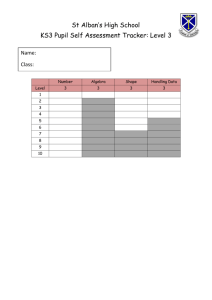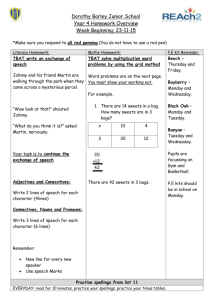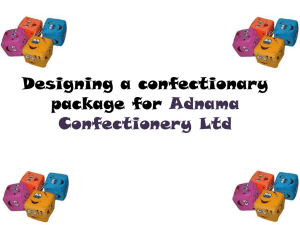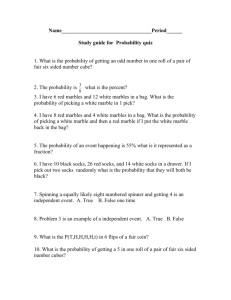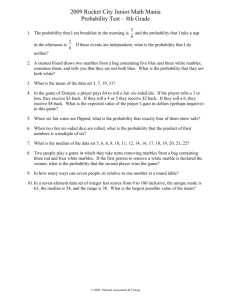Lesson_H_Probability
advertisement
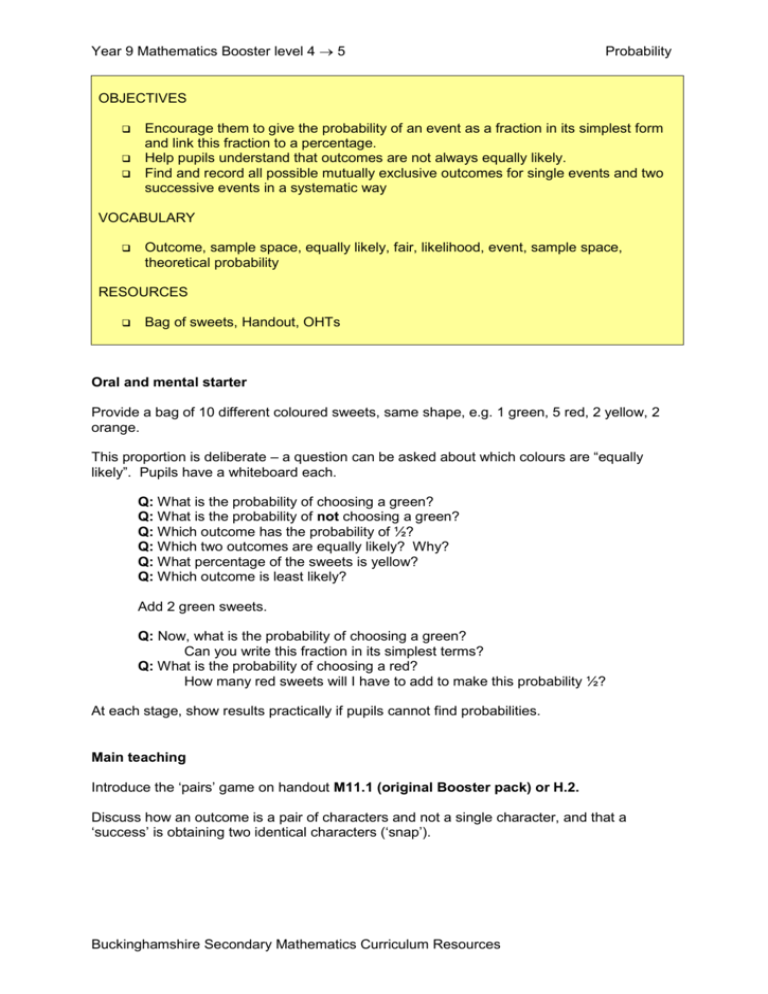
Year 9 Mathematics Booster level 4 5 Probability OBJECTIVES Encourage them to give the probability of an event as a fraction in its simplest form and link this fraction to a percentage. Help pupils understand that outcomes are not always equally likely. Find and record all possible mutually exclusive outcomes for single events and two successive events in a systematic way VOCABULARY Outcome, sample space, equally likely, fair, likelihood, event, sample space, theoretical probability RESOURCES Bag of sweets, Handout, OHTs Oral and mental starter Provide a bag of 10 different coloured sweets, same shape, e.g. 1 green, 5 red, 2 yellow, 2 orange. This proportion is deliberate – a question can be asked about which colours are “equally likely”. Pupils have a whiteboard each. Q: What is the probability of choosing a green? Q: What is the probability of not choosing a green? Q: Which outcome has the probability of ½? Q: Which two outcomes are equally likely? Why? Q: What percentage of the sweets is yellow? Q: Which outcome is least likely? Add 2 green sweets. Q: Now, what is the probability of choosing a green? Can you write this fraction in its simplest terms? Q: What is the probability of choosing a red? How many red sweets will I have to add to make this probability ½? At each stage, show results practically if pupils cannot find probabilities. Main teaching Introduce the ‘pairs’ game on handout M11.1 (original Booster pack) or H.2. Discuss how an outcome is a pair of characters and not a single character, and that a ‘success’ is obtaining two identical characters (‘snap’). Buckinghamshire Secondary Mathematics Curriculum Resources Year 9 Mathematics Booster level 4 5 Probability Ask pupils to work in pairs and carry out the experiment to estimate the probability of a snap. Q: How are you going to record your results? Q: How many times are you going to repeat the experiment in order to get a meaningful result? Allow time for pupils to complete their experiment and to estimate the probability. Compare their estimates. Discuss any issues that arise. Next introduce a theoretical approach to the problem. Q: What are the possible outcomes in the ‘pairs’ game? Q: How can you be sure that you have found them all? Q: How can you list them systematically? Encourage pupils to use a systematic method of recording the outcomes, for example: aa ab ac a a aa b ba c ca Or ba b ab bb cb bb bc ca cb cc c ac bc cc Q: Using the list of outcomes, what is the theoretical probability of winning? Worksheet H.3 for further examples or homework Plenary Use the sweets from oral and mental starter to create two boxes/bags, one of which contains 8 red sweets and 10 “not red” and the other contains 6 red and 12 “not red”. Q: Kate only likes red sweets. She can pick a sweet at random from either box. Which box should she pick from? Why? Q: Kate is given a third box of sweets with 15 red and 12 “not red”. Which box should Kate choose from now? Why? Buckinghamshire Secondary Mathematics Curriculum Resources Year 9 Mathematics Booster level 4 5 Probability Probability Worksheet H.3 1. A school is holding a raffle where the first prize is a CD player. The names of all the pupils, all the teachers and all the office staff are put into a hat. One name is picked out at random. A pupil says : “There are three choices. It could be a pupil, a teacher or one of the office staff. The probability of it being a teacher is 1 ”. 3 Write down why the pupil is wrong. 2. George has 7 red marbles in a bag. He wants to make it more likely that he will take a green marble than a red marble out of the bag. How many green marbles should George put in the bag? 3. In another bag, there are 20 marbles altogether. The marbles are either red or green. It is equally likely that George will take a green marble or a red marble from the bag. How many green marbles and how many red marbles are there in the bag? 4. A cereal manufacturer is giving away one free sticker in each box. You cannot tell which sticker is in a box. Each sticker is equally likely. There are four different stickers: Beckham, Campbell, Giggs and Scholes. Amit and Claire are collecting the stickers. Claire needs Beckham. Amit needs Giggs and Scholes. They buy one box of cereal. Q: What is the probability that the sticker is one that Claire needs? Q: What is the probability that the sticker is one that Amit needs? Q: Their friend opens the box. She tells them the sticker is not Beckham. Now what is the probability that the sticker is one that Sarah needs? Q: What is the probability that the sticker is one that Amit needs? 5. Jack has two drawers of socks. The top drawer contains 16 red socks and 24 blue socks. The bottom drawer contains 20 red socks and 32 blue socks. Q: He needs a red sock. He’s going to pick one sock from a drawer at random. Which drawer should Jim choose? Show how you found the answer. 6. Jack and Sarah choose from this menu Menu Main course Roast chicken dinner - Hamburger and chips - Vegetable Lasagne Dessert Ice cream - Banana split - Profiteroles Q: Draw a sample space diagram to show all the possible meal combinations. Buckinghamshire Secondary Mathematics Curriculum Resources Q: Jack is vegetarian. List all the possible meals that he could eat.


